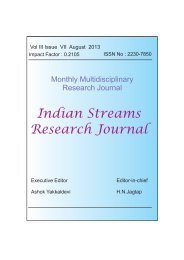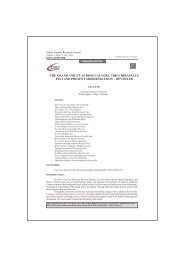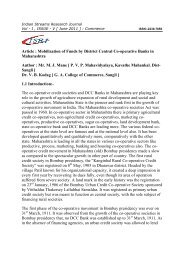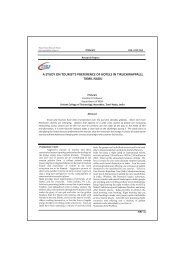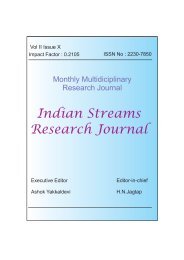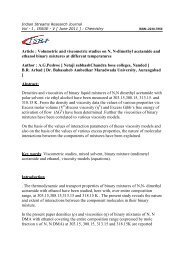M. GOPAL SINGHA - Indian Streams Research Journal
M. GOPAL SINGHA - Indian Streams Research Journal
M. GOPAL SINGHA - Indian Streams Research Journal
- No tags were found...
You also want an ePaper? Increase the reach of your titles
YUMPU automatically turns print PDFs into web optimized ePapers that Google loves.
CHANGING ECOLOGICAL SYSTEM AND PROBLEM OF SUSTAINABLE........the East Garo Hills of Meghalaya through Rangjuli in the west and Dhanubhanga in the east.Flora and Fauna: The geo-environment of Naitara_Chautora wetland provides a wide scope and theluxuriant growth of flora and avifauna along with fauna of neighboring hills. It may be mentioned that untilrecent past the wetland was almost uninhabited except a sizeable Scheduled Caste people (Koibrotos)having their caste based occupation of fishing. The wetland in the past happened to be one of the resourcefulecological setting with vast water reserve, maximum depth of 10-15 ft., plenty of plants and microorganisms. Despite the depletion of its resourceful biotic components with the changing humanenvironment, the wetland is still endowed with the substantial biological diversity. The biological diversityof Naitara-Chautora wetland can be grouped as follows:(i)Plant species,(ii) wild life, mammals, micro-organisms and fish fauna and (iii) birds.The primary plant species of this wetland which are the main producers and found in floating orsuspended or rooted conditions are algae and other aquatic plants. Among the aquatic flora mention may bemade of water star, weter hyaccin, lily( nymphea naucheli), lotus (nymphealotus) Numpphea steleta,azolla, Potamogeton, pistia, Wolffra, Lemna, Jussaica, dal(Brachiarea Psendointarpeta), hydrila ( HydrilaVestiollation), Bor puni (Eichhomia crassipes), Btholongi(Poly gonum sp.) etc. Besides, a large number ofplants and grasses are grown on the edge of wetland. Among the endemic dominant species worthmentioning are nal (Arundo donax) , ulu (Impereta cynrica), birina( Andropogon Spontaeum), arati(Cyperus iria), kahuwa (Sacharum Spontaneum), buffalo grass, ekra (Erianthus ravennal), Khagori(Phragmites Korka) etc. Apart from these a wide ranging species of trees , medicinal plants , creepers,shrub, herbs and grasses are found in the wetland and the fringing hillocks. The endemic species of trees areSal ( Shorea robusta), Teak (Tectotona grandis), Simul (Bombax malabricum), Gomari(Gmelina arborea),Makar sal ( Shorea assamica), etc.(ii)Wild life, mammals and micro-organisms :This wetland ecosystem has a large number of zooplanktons, insects, amphibians, reptiles andmammals. Among zooplankton and insects rotifers, water beetles, water boatmen, pond skater (Gerrislacustris), etc. are worth mentioning for their adaptability. Snakes, monitor lizards, turrapins more than 6species of leaches, etc. form the reptile and mammals of this wetland. It is imperative to note that thewetland and its neighborhood is rich in mammals, arthropod and mollusk. With the changing ecologicalcondition arising out of population pressure and habitat loss mammals and other aquatic animals aredisappearing from the wetland and neighboring hill forests.Fish fauna: So far the fish fauna of this aquatic ecosystem is concerned a wide ranging species arefound. Out of 155 species of fishes found in Eastern Himalaya region as many as 45 fish species are stillfound in this wetland. But quite a few fish species which were once formed dominant variety like Aari(Aorichthys seenghala),Barali(Wallago attu),Shol(Channa stratus), Sal (Channa marulius),Chitol(Notopterus Chitala),Korati(Gudusia), etc. are fast dwindling in this wetland. Besides,Pabho(Orupak), Garua(Beguriusbagurius), Kakila(Xenentodon Cencilia), etc. have become endangeredspecies.(iii)Birds: Naitara-Chautora wetland in the recent past happened to be abode of exotic birds like peacock,hornbill, short nacked swan, Bengal florican, Crane, etc. But these bird species have become rare visitor ofthis wetland now. Of course, indigenous species like Panikaouri (Phalacrocorx), Sarali(Demdrocygna),Bagali(Egrett garzetta), Kingfisher, Dauk(Amouroris Phoenjurus),Pintailed duck, Deoha(White wingedDuck) etc. are abundantly found in this wetland.Hazard of changing ecology: The source of ecological change of Naitara-Chautara wetland may beattributed to the following aspects:1.Population Pressure: The pressure of ever increasing population has tremendous impact on land, water,biotic, components and economy of the wetland. The expansion of habitable places in the wetland has led toexploitation of forest cover in Shitolmari, Buragohain and Arakhowa hillocks and cutting of hill slopes forquarrying and farming. Stone quarrying which is taking place in a half a kilometer away from the wetlandposes a great threat to the wetland. Besides, extensive cutting of earth for new farming lands in thesurrounding areas of the wetland has led to soil erosion and siltation.2. Siltation: High rate of silt deposition is observed in the wetland. According to an estimate 5 lakh tones ofsilt is annually deposited in Naitara-Chautora wetland through two rivers namely Kornoi and Juria.<strong>Indian</strong> <strong>Streams</strong> <strong>Research</strong> <strong>Journal</strong> • Volume 3 Issue 3 • April 20135
CHANGING ECOLOGICAL SYSTEM AND PROBLEM OF SUSTAINABLE........Scheduled Caste people have their caste based fishing occupation. Out of 48 households, 19 householdsare surveyed in the village. The surveyed households have a total population of 134, having an averagefamily size of 7.05(=7). The female population (52.98%) is higher than that of male (47.01%) counter part.Age group wise population reveals high percentage of working population(36.53%), 21-50 years of age.So far the literacy rate is concerned the village has low level of literate population (26.11%). The village hadnot a single matriculate even up to the year 2006. The village represents a state of backward economy. Asthe people have no adequate share of agricultural land, they have to depend only on fishing. But in recentdecades their occupational structure have been changing from fishing to other means of livelihood. It isobserved from Table that fishing activities support only 26.31 % while wage labour (40.10 %) supportssubstantial population.. This village is backward in every aspect of development. Most of the householdsare under poverty line. It is worth mentioning that a sizeable proportion of the households is recognized aslandless having no or little (0.07 hectares) land. The villagers are in constant search of new shallow part of'beel' periphery for paddy cultivation.SOCIO-ECONOMIC PROFILE OF GORUCHATKA VILLAGE:Goruchatka is another SC village situated in the southern fringe of Naitara-Chautora wetland. Thevillage is under Goruchatka Part-I revenue of Tiplai Goan Panchayat. This village is also one of the age-oldvillages inhabited by SC communities belonging to Koibrotos. The people of the this community solelydepend on fishing and selling of fishes. The total SC population of Goruchatka is 318 Persons(155 male and163 female) according to 2001 Census. It is important to note that the SC population of this has beendecreased in comparison to the total population of 1991 census (345 persons, male 179 and female 166).Out of 63 total households 30 which are actively engaged in fishing are surveyed. Surveyed householdshave a total population of 132, having an average family size of 4. The occupational structure of the villageshows that still fishing occupies a high percentage of 33.33% while wage labour (36.66%) forms anothermajor occupation. The changing wetland ecosystem scenario compels the fishermen to shift their way ofearning other activities. The fishermen also engage in agricultural activities to a substantial proportion(13.33), while operational holding reveals higher number of households under landless, marginal and smallcategories.The village is socio economically very backward. The literacy rate of the village is 32.52 percent,while is quite below the neighbouring villages and the district.ECONOMY OF THE VILLAGES:Fishing activities form a major sector of economy of the three representative villages andsurrounding other villages of Naitara-Chautora wetland. The wetland with its rich fish-fauna in recent pastcontinued to provide ample economic opportunity to the inhabitants particularly to the fishing community.In the changing decades fishing economy has also changed its structure and dimension. The fishingeconomy of Naitara-Chautora 'beel' is controlled by the fishermen of this locality. These people amongthemselves have fishermen, sellers, middlemen, agents and Mahaldars (Contractors). Fishing activitieshere take place as a commercials activity. It occupies a major percentage share of economy of these S.C.villages (Table: 2). Agriculture also occupies another major sector of economy for the Scheduled Castefishing community of Naitara-Chautora Wetland. Agriculture as it is a major source of economy; variouscrops are cultivated as to meet the need of the people. Among the various crops cultivating in this area rice ispredominant crop which is operating by the maximum number of the households. The production of rice isin subsistence level. In recent years Boro rice in winter season is most popularly cultivated in this area.Besides, paddy cultivation, other farming activities like horticulture, livestock farming etc. are also gainingimportance as subsidiary source of income.<strong>Indian</strong> <strong>Streams</strong> <strong>Research</strong> <strong>Journal</strong> • Volume 3 Issue 3 • April 20137
CHANGING ECOLOGICAL SYSTEM AND PROBLEM OF SUSTAINABLE........Table: 2Socio –economic characteristics of Bhakatpara, Ulubari and Goruchatka S.C villageNam eSurve yedVillageBhakatparaUlubariGoruchatkaofLocation No. ofSurveyedHouseholdLow-lyingplainLow-lyingplainB ui lt-upP lainTotalP opul ationof S urveyedH ousehol dHousehol d under different occupationsFishing20 118 7(35%)19 134 5(26.31%)30 132 10(33.33%)Agri/Poultry6(30%)5(26.31%)4(13.33)Wa ge labour Business Servi ce1(5% )8(42.10% )11(36.66% )3(15%)1(5.26% )4(13.33)3(15%)NIL3(3.33% )Sour ce : B ased on socio-econom ic survey by researcher, 2009Table: 3Occupational Structure of Bhakatpara, Ulubari and Goruchatka S.C villageName of No. of Total Household under differentSurveyed Surveyed Population occupationsVillage Household of SurveyedHousehold Primary Secondary TertiaryBhakatpara 20 118 14(70%)4(20%)2(10%)Ulubari 19 134 18 1 NIL(94.74%) 5.26%)Goruchatka 30 132 25(83.33%)413.33%)1(3.34%)Source: Based on socio-economic survey by researcher, 2009Table: 4Socio –economic characteristics of Bhakatpara, Ulubari and Goruchatka S.C villageName ofSurveyedVillageBhakatparaUlubariGoruchatkaLocation Community No. ofSurveyedHouseholdLow-lyingplainLow-lyingplainBuilt-upPlainS.C(Assamese)S.C(Namsudra)(Bengali)S.C(Assamese)TotalPopulationofSurveyedHouseholdLiteracy Household under differentoccupationsPrimary Seconda Tertiaryry20 118 77.47% 70% 20% 10%19 134 26.11% 94.74% 5.26% NIL30 132 32.52% 83.33% 13.33% 3.34%Source : Based on socio-economic survey by researcher, 2009<strong>Indian</strong> <strong>Streams</strong> <strong>Research</strong> <strong>Journal</strong> • Volume 3 Issue 3 • April 20138
CHANGING ECOLOGICAL SYSTEM AND PROBLEM OF SUSTAINABLE........CONCLUSION:The existing physical framework, socio-economic attributes including population dynamics,socio-cultural attitudes of the fringing Scheduled Caste villages as well as other resource users ofneighboring villages have far reaching impact on the pattern and processes of ecological system andassociated problems of sustainable development of Naitara-Chautora Wetland. The wetland ecosystem likeother major ecosystem of the state and that of the country is facing the problem of environmentaldegradation and ecological change since the beginning of sixtee's. The foregoing analysis depicts that thewetland ecosystem of Naitara-Chautora has been changing due to over exploitation years together. TheScheduled Caste people inhabiting in the fringe have to suffer as their primary occupation of fishing has nolonger been a major occupation.It is observed from the analysis that the villages especially the Scheduled Castes in the fringingareas of wetland who are the active resource users and exploiters of the 'beel' have been experiencing theacute problem of sustainability. Besides, the problem of ecological change may create hazardousconsequences in the near future. Hence, a concerted effort to check the changing ecological conditionshould be made through appropriate strategies before it is too late. The research study of this area would bemore appropriate if a team of biologists, ecologists, environmentalists and Geographers examine the microecosystem in detail with reference to the problem of sustainable development of the fringing villages.From the findings of investigations and observations the following suggestion andrecommendations for management can be put forward so as to offset the changing ecology and problem ofsustainable development issues.(1)An integrated development programme for Naitara-Chutora wetland may be formulated taking intoconsideration of the need of fringing Scheduled Caste inhabitants.(2)Stringent measures should be taken to conserve the wetland by checking siltation from the rivers andstone quarries near the hills of wetland.(3)Anthropogenic threat to wetland by indulging in overfishing and killing of avifauna and birds should bechecked with imposition of restrictions.(4)This wetland should be brought under supportive and appropriate legislation and appropriate legal asspecial area.(5)The transformation of shallow part of the wetland into paddy field in winter season must be checked inorder to keep intact the wetland area.(6)Certain conductive areas of wetlands should be reserved as feeding grounds or nursery or caves for fishand other avifauna.(7)Mass awareness and special awareness programmers for fringing Wetland inhabitants should beinitiated so as to conserve the wetland in meaningful and sustainable way.REFERENCES:I.IUCN,1971: Ramsar Convention: 'The Final Act of theInternational Conference on the ConservationOf wetlands and waterfowl” IUCN Bulletin,2SpecialSupplement.2.Mathur,H.S and Binda, P.R.,1990 : Land Resource EvaluationBy Remote Sensing, PointerPublishers,Jaipur,pp.1-2233. Parikh and DATYE, 2003: 'Sustainable Management of Wetlands,Biodiversity and beyond', Sage Publications,New Delhi,p.72.4. Singha, M.G., 1996 : Geo-Ecological Perspectives on RegionalDevelopment in Assam: A GeographicalAnalysis, Unpublished PhD Thesis,Gauhati University, Assam.5. Wetland Directory, 1990 : Ministry of Environment and Forest, Govt. of India.<strong>Indian</strong> <strong>Streams</strong> <strong>Research</strong> <strong>Journal</strong> • Volume 3 Issue 3 • April 20139




